When customers join your gym, they’re looking for one main thing: results. Implementing a fitness assessment system will not only enable your customers to effectively measure their results, but also give you insight into your customer base.
Here, we break down what a fitness assessment is, what factors to consider, the measurements you should include, and how to assess fitness goals.
What is a fitness assessment?
A fitness assessment is a short survey used to evaluate a gym customer’s current fitness level, fitness history, and their goals.
The format can be as simple as a quick Google Form, or you can add in some personal physical assessments.
The benefits of fitness assessments
Fitness assessment data is much more than just a client check-up. Gym owners and other fitness industry professionals can use them to foster community and get new ideas.
Set benchmarks
A well-designed fitness questionnaire can determine a gym client’s current level of wellness. Their results can be used in the future to see how far they’ve come.
These benchmarks can also be used gym-wide. Can your fitness community raise their average scores together?
Understand your clientele
If you organize your assessment data in easy-to-read dashboards, you can see where your gym members’ fitness levels are. Are your customers already very fit and looking to maintain? Are they elite athletes? Or are they average and trying to get better? Knowing where they stand will help you see your business in a new light.
Plan new programs
When you understand your gym’s customers better, you can build your business around their needs. Fitness assessments can help you get ideas for new offerings or exercise programs to go beyond the trends.
When to offer a fitness assessment
These questionnaires can be offered as often as they are relevant. Here are a few ideas for scheduling your assessments.
New membership
Offer an assessment as soon as someone signs up for a gym membership. It shows the customer that you are invested in their wellness, and you get valuable data on new members.
Changing goals
Fitness assessments aren’t always one-size-fits-all. Someone looking to pack on muscle and someone looking to lose lots of fat may want very different benchmarks.
Encourage members to fill out a new assessment whenever their goals change. Make sure you have a few different sets of fitness survey questions prepared for these goals ahead of time.
Monthly or quarterly
Many gym members are looking for consistency – and consistent progress. If their goal is long-term, ask them to fill out a survey every month or every quarter.
This will show them how they’re performing against their benchmarks. It will also give gym owners and personal trainers an idea of how effective their programs are.
Elements to consider
When building your facility’s fitness assessment, these basic factors will affect your customers’ answers – and what you do with them. Ask about them directly on the survey and keep them in mind when interpreting answers.
Age
Different ages have different recommended amounts of weekly exercise. The CDC recommends the following based on the needs of various age groups:
Adults 18 to 64
Those in this age group should get at least 150 minutes of moderate exercise per week. They should also work in strength exercises at least two days per week.
Adults 65+
Recommendations for these adults are the same as those 18 to 64. However, it’s also recommended that they add in activities that can improve balance.
Physical ability
What is impacting your members’ level of physical ability? For example, someone who uses a wheelchair will have different abilities (and needs) than someone who doesn’t.
For those with chronic conditions and/or disabilities, the CDC recommends at least 150 minutes of aerobic exercise per week in addition to two days per week of muscle training. Pregnant people should also get 150 minutes of exercise per week.
Previous injuries
Past injuries can affect a member’s current abilities. You may want to ask about affected body parts and how long ago the injuries occurred.
This can also inform the types of exercise and warmups you recommend. For example, a member may have the goal of increasing their running distance but have a history of shin splints. Knowing to recommend pre-run stretches will be good for them and improve your client relationship.
Exercise experience
Some of your gym’s members may be seasoned workout professionals. Others may be working out for the first time in their lives.
A member’s experience level will not only affect their answers on your assessment, but also how they interpret their results and recommended course of action. Frequent exercisers will understand gym jargon, but newbies will need a little more hand-holding.
Diet
A gym member’s diet can help or hinder their progress. If you don’t ask about it directly, make sure to offer more information on diets that will contribute to fitness success.
Capacity and time
How much time at the gym can your customers realistically handle? This will vary depending on family situations, careers, or even how close someone lives to the facility.
Customer goals
The most important thing to keep in mind when someone fills out your gym’s assessment is what their goals are. Their satisfaction with your facility depends on the results they see, and knowing their goals will help you push them toward the results they want.
You can also realistically evaluate their goals using the assessment and the other elements above. For example, say that one of your customers has a goal of losing twenty pounds this month but only has a couple hours a week to come to the gym. Use this to spark a conversation about shifting either their goal or their time commitment.
What to include in a fitness assessment
Before diving into goals and timelines, your fitness survey should start with very basic health questions. It will almost feel like the paperwork you fill out at the doctor’s office.
Then you’ll get a little more granular with some fitness-related assessments. We used this info from the Mayo Clinic for some standard guidelines.
Height and weight
After name and birthday, ask about height and weight. For those looking to lose or gain, this will act as a benchmark. It will also help you determine the customer’s BMI.
Body mass index (BMI) is one of many ways health professionals can determine if someone has a healthy weight. This calculator from the National Heart, Lung, and Blood Institute uses height and weight to calculate BMI.
Keep in mind that BMI is not always a reliable indicator of a healthy weight, especially for very muscular builds. This is because it doesn’t distinguish between excess fat and excess muscle.
Body fat
In this section of the questionnaire, take some body measurements that will help you determine the customer’s body composition. One important measurement is the waist-to-hip ratio.
Using a tape measure, record the circumference of the smallest part of the waist and largest part of the hips. If the waist is larger than the hips, that may indicate a health problem.
Next, get a little more technical by breaking down the body composition and measuring body fat percentage. You can do this with simple tools like skinfold calipers or a bioelectrical impedance analysis (BIA) device.
A person’s body fat percentage reflects how much of their body is composed of fat. On average, women’s body fat percentage will be higher than men’s. These charts from Medical News Today break it down further by gender and age.
Heart rate
Measuring heart health is an important part of getting the full picture of someone’s fitness level. Start with resting heart rate.
Resting heart rate
Your resting heart rate is a measure of how many times your heart beats per minute when your body is at rest. A healthy resting heart rate is usually between 60 and 100 beats per minute.
With regular exercise, a high resting heart rate may become lower over time. Get your baseline with the fitness assessment and see how it changes after a few months.
1.5-mile run
Another way to measure your heart health is through an aerobic fitness test, such as running a mile and half. The ideal run time varies by age.
| Age | Women: Time in minutes | Men: Time in minutes |
| 25 | 13 | 11 |
| 35 | 13.5 | 11.5 |
| 45 | 14 | 12 |
| 55 | 16 | 13 |
| 65 | 17.5 | 14 |
Table from Mayo Clinic
Strength and endurance
Use pushups and situps as strength tests to get a baseline level of a gym member’s muscular fitness.
Pushup test
Find out the maximum number of pushups your gym customer can do. They can self-report this, or a trainer can observe them.
On average, men should be able to do more pushups than women and younger people should be able to do more than older people.
| Age | Women: Number of pushups | Men: Number of pushups |
| 25 | 20 | 28 |
| 35 | 19 | 21 |
| 45 | 14 | 16 |
| 55 | 10 | 12 |
| 65 | 10 | 10 |
Table from Mayo Clinic
Situp test
Count the maximum number of situps your customer can do. They can self-report or get help counting from a personal trainer.
| Age | Women: Number of situps | Men: Number of situps |
| 25 | 39 | 44 |
| 35 | 30 | 40 |
| 45 | 25 | 35 |
| 55 | 21 | 30 |
| 65 | 12 | 24 |
Table from Mayo Clinic
Flexibility
There are a few different ways to measure flexibility. Start by asking if the gym member can touch their toes from a standing position. Many people measure their own flexibility by this one factor, so it’s good to take note of it before starting an exercise program.
Sit-and-reach is a standard test of flexibility. To get this benchmark, ask the client to sit on the floor with their legs outstretched.
A yardstick should be placed between their legs with their feet landing on either side of the fifteen-inch mark. Ask them to reach as far as they can past their feet, holding for one full second. Use the best of three tries.
| Age | Women: Farthest reach | Men: Farthest reach |
| 25 | 21.5 in. (55 cm) | 19.5 in. (50 cm) |
| 35 | 20.5 in. (52 cm) | 18.5 in. (47 cm) |
| 45 | 20 in. (51 cm) | 17.5 in. (44 cm) |
| 55 | 19 in. (48 cm) | 16.5 in. (42 cm) |
| 65 | 17.5 in. (44 cm) | 15.5 in. (39 cm) |
Table from Mayo Clinic
Building fitness goals into the assessment
Once your customer knows where their fitness level stands, it’s time to record their goals so they can track their progress.
Don’t just leave a blank space where clients can write down whatever goals they want. At the end of your assessment, build in goal-oriented questions that follow the S.M.A.R.T. format.
Specific
A goal like “I want to lose weight” is flimsy, and flimsy goals are hard to stick to. If a gym member wants to lose weight, ask them to be specific. How many pounds and ounces are they looking to lose?
Measurable
A specific amount of weight loss is one example of a measurable goal. Some others include adding a number of reps to a weight lifting set, running a mile a few minutes faster, or losing an inch and a half off their waist.
Every time someone retakes the fitness assessment, make sure to check these goals and record updated numbers. They could also record their own progress if they have personal fitness technology.
Achievable
When asking about their goals, make sure the customer knows whether the goal is realistic. Losing 40 pounds in a month is a stretch, but five might be a good place to start.
Relevant
A customer might think they can get their ex back with a little bit of training, but that’s not something you can actually measure at the gym. Remind customers that their goals should be directly related to what they can accomplish at your facility.
Time-bound
Each goal should have an associated time limit. Whether it’s in a day, a month, or a year, ask exactly when your client wants to accomplish their goal.
Final thoughts
Providing a standardized fitness assessment to your gym customers is the ideal way to make them feel like you’re invested in their progress. A thorough questionnaire that helps members track their goals will help you stand out from the rest of the fitness market and set you apart as a gym owner that cares.
Using this article as a basis for your questions, create a survey that works for your gym. Your facility survey will help current members improve and attract new members.

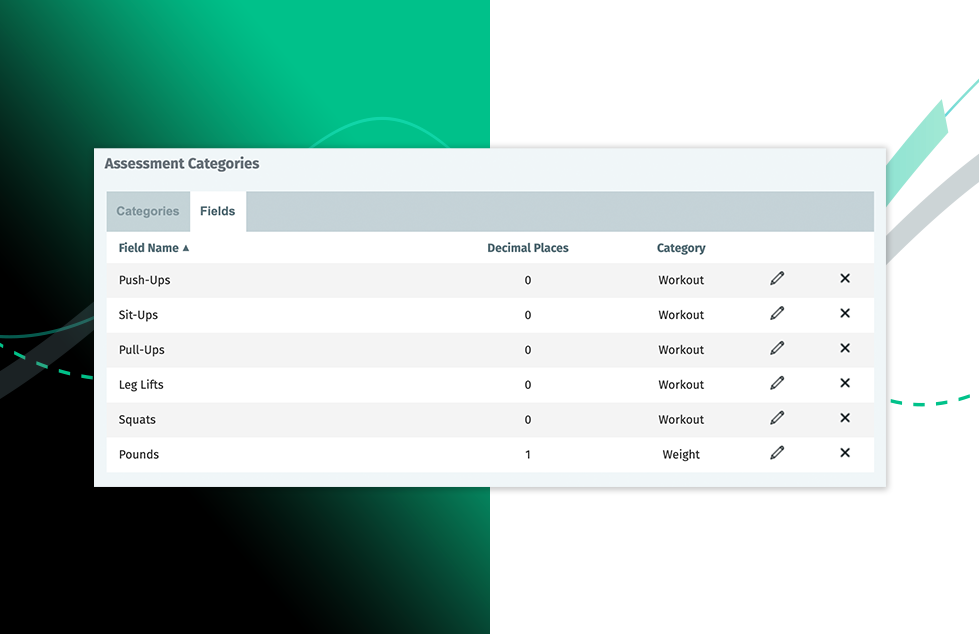
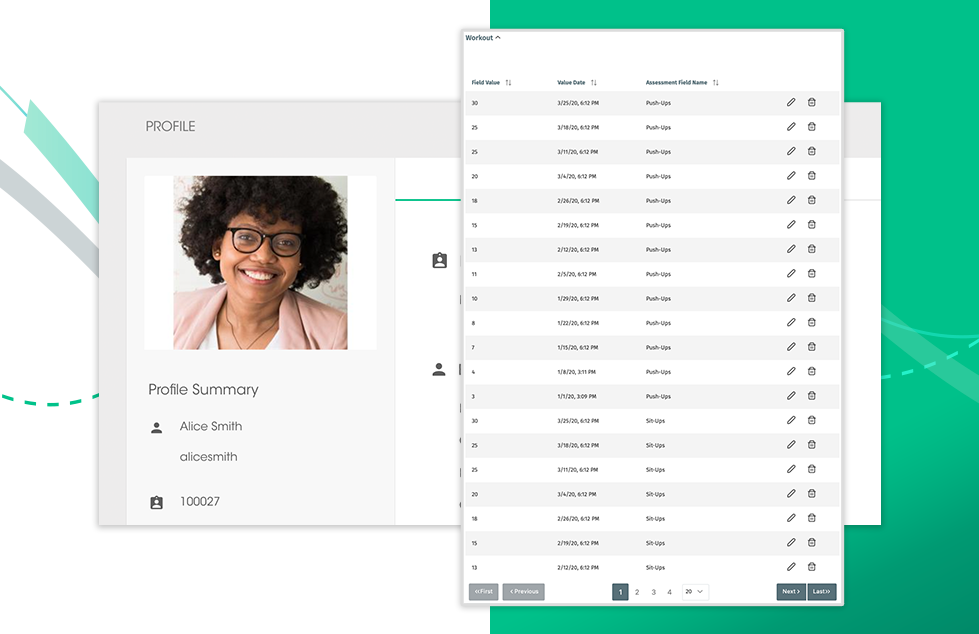
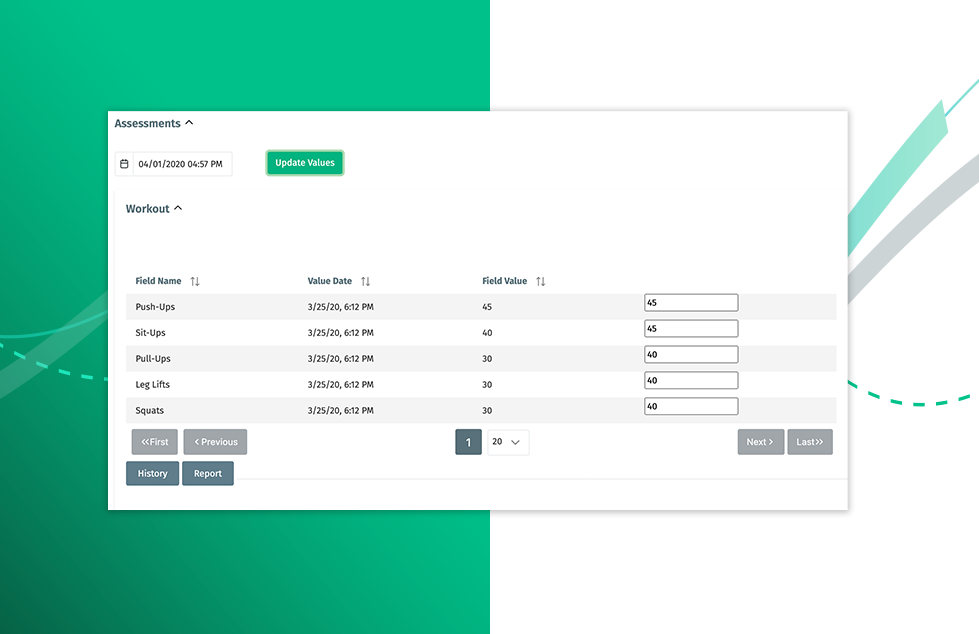
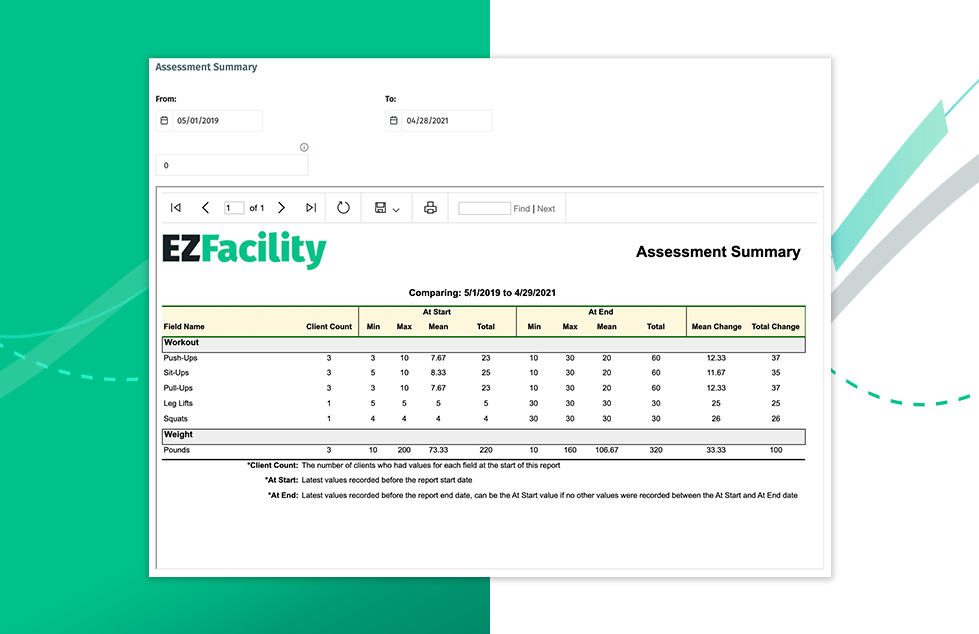
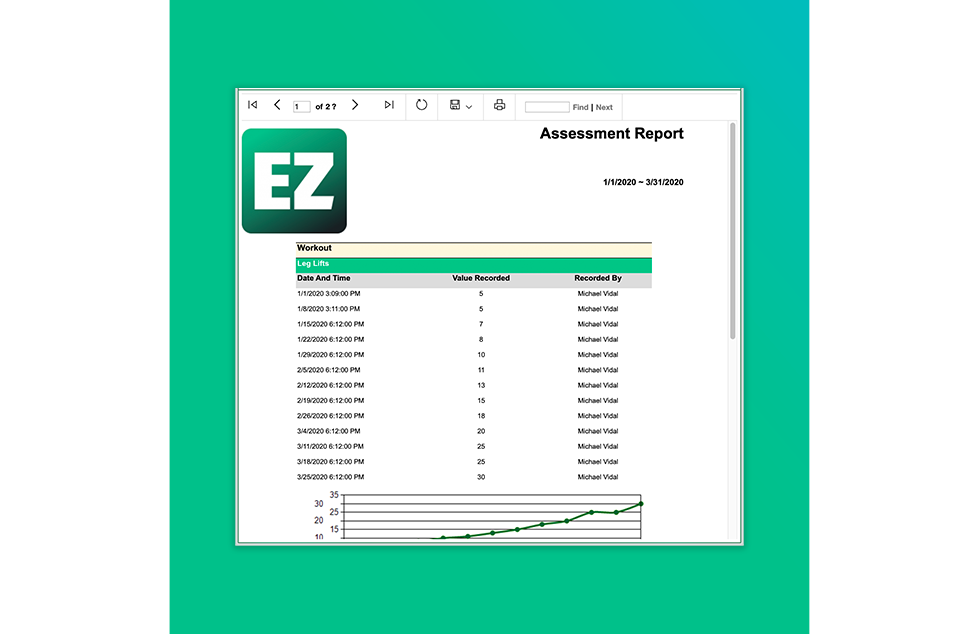
Do you offer any software programs for personal trainers which diagrams of exercises/muscles used?
Our software is more for business and client management, but we do have fitness assessment/tracking tools. As of right now, those assessment tools do not contain diagrams, but I can suggest to our team that we add the ability to upload custom exercises with images in a future update. If you’re a current EZFacility customer and have a Branded App, you can add this kind of content as articles to your app for your clients to access at any time!